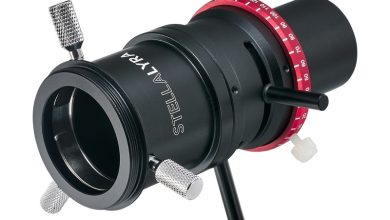Top 10 Best Astronomy Books for Beginners
Start Your Cosmic Journey in real pages not digital ones!

The allure of astronomy lies in its unique blend of scientific inquiry and poetic wonder which can be found in Astronomy Books for Beginners. Throughout history, the study of the cosmos has served as a bridge between the realms of philosophy, science, and art, demonstrating the interconnectedness of human endeavors. By turning our gaze upwards, we embark on a journey that transcends temporal concerns, connecting us with ancient observers whose eyes once traced the same constellations across the night sky. Astronomy, therefore, is not merely a scientific discipline but a cultural and existential exploration, shedding light on the most profound questions: Who are we? Why are we here? How does the universe operate?
The importance of astronomy extends beyond its capacity to inspire awe and curiosity. It is a beacon of human achievement, marking significant milestones in our collective quest for knowledge. From the revolutionary heliocentric model proposed by Copernicus to the groundbreaking detection of gravitational waves, astronomical discoveries have continually reshaped our understanding of the universe. These achievements underscore the pivotal role of astronomy in advancing science, technology, and mathematics, while also enriching our cultural heritage and philosophical insights.

Choosing Your First Astronomy Books for Beginners
Venturing into the expansive universe of astronomy as a novice can be as thrilling as it is overwhelming. The cosmos, with its vast expanse and intricate mysteries, beckons with a promise of discovery and wonder. Your guide through this celestial journey? A carefully chosen astronomy book. The perfect astronomy book for beginners isn’t just a repository of knowledge—it’s a beacon, illuminating the path to understanding the cosmos. When selecting your first companion in this adventure, consider these pivotal factors: readability for beginners, practical stargazing advice, and the richness of content.
- Readability for Beginners
The ideal astronomy book speaks in a language that resonates with newcomers, transforming complex astronomical concepts into digestible, engaging narratives. It should invite curiosity and encourage further exploration, making the vastness of the cosmos accessible to those standing at the threshold. Books that excel in explaining the rudiments of astronomy without assuming prior knowledge create a welcoming entry point into the field.
- Practical Stargazing Tips
A book that bridges the gap between theoretical astronomy and the tactile experience of observing the night sky has immeasurable value. Look for books enriched with practical tips—those that guide you in choosing the right telescope, understanding celestial movements, and planning successful stargazing sessions. A book that equips you with the knowledge to identify constellations, track planets, and witness meteor showers transforms readers from passive learners into active participants in the cosmic ballet.
- Depth of Content
Depth of content is crucial. A comprehensive book delves into topics beyond the basics, offering insights into telescopes, celestial events, and the fundamentals of cosmology. It provides a solid foundation in astronomy while sparking curiosity about complex subjects like black holes, the life cycle of stars, and the structure of the universe. This depth ensures that as your knowledge grows, your guide remains relevant, continually offering new layers of understanding.
Before starting the introduction of the books, in this video by Ed Ting, you can see the introduction and description of some of the books that we will introduce in the following, as well as some other books:
BEST Astronomy Books for Beginners
Among the myriad of options, several titles stand out for their ability to enchant the novice astronomer:
1. Turn Left at Orion
“Hundreds of Night Sky Objects to See in a Home Telescope – and How to Find Them” by Guy Consolmagno and Dan M. Davis.
“Turn Left at Orion” is a seminal work in amateur astronomy, renowned for demystifying the night sky for those with home telescopes and its essentials such as ADC. With over 150,000 copies sold, its enduring popularity is a testament to its accessibility and depth. The book’s unique format of object-by-object spreads, coupled with practical tips and clear illustrations, guides readers through observing celestial wonders. Its spiral binding and large pages make it an indispensable companion for nighttime observations.
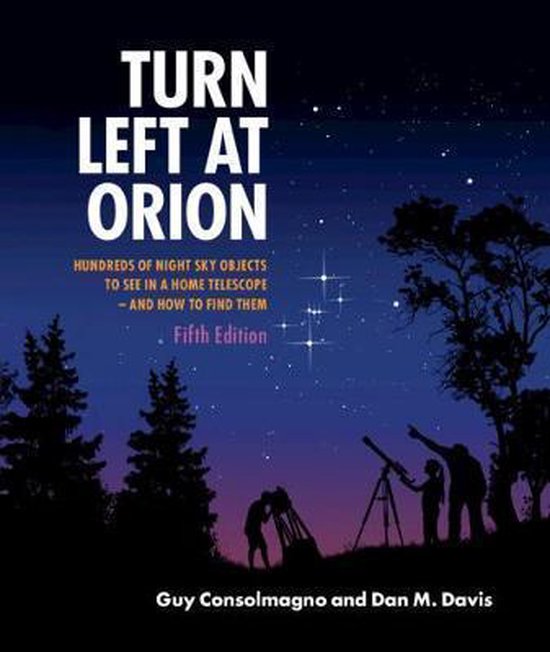
Unique Selling Points (USPs)
- Spiral-bound format for ease of use outdoors.
- Object-by-object spreads showing what celestial objects look like through small telescopes.
- Dedicated chapters for both Northern and Southern Hemisphere objects.
- Updated star names and astronomical information, with a link to a dedicated webpage for up-to-date tables and images.
Target Audience
The book caters to amateur astronomers of all levels, from complete beginners to more experienced stargazers looking for a comprehensive guide to the night sky.
Critical Reception
Praised by critics and readers alike, it’s been highlighted for its ability to make stargazing accessible and enjoyable. Sky & Telescope’s Dennis Di Cicco called it “an essential guide” for telescope owners, while Astronomy Now’s Keith Cooper noted it’s a must-have for both beginners and experienced amateur astronomers.
“Simply put, whatever your level of experience, you must have this book!” – Glenn Chaple, Astronomy.
Comparisons
“Turn Left at Orion” is often compared to other stargazing guides like “NightWatch” by Terence Dickinson, for its practical approach to amateur astronomy but stands out for its object-by-object viewing strategy and usability in the field.
Author Background
Guy Consolmagno and Dan M. Davis bring a wealth of astronomical expertise and passion to this book. Consolmagno, a Jesuit brother, serves as the director of the Vatican Observatory and is a respected astronomer and planetary scientist. Davis specializes in the field of astronomy education, making them a formidable team in bringing the cosmos closer to amateur astronomers.
Reader Reviews and Ratings
The book boasts a stellar 4.7 out of 5 stars rating on Amazon, with readers lauding its clarity, utility, and the way it enhances the stargazing experience.
The latest edition includes links to a dedicated webpage with up-to-date tables and images, alongside an improved planets chapter, ensuring readers have the most current information at their fingertips.
“Turn Left at Orion” continues to be a beacon for those venturing into the night sky, offering a blend of scientific rigor and the simple joy of discovery that is rare in astronomy literature.
2. NightWatch
“NightWatch: A Practical Guide to Viewing the Universe” by Terence Dickinson
“NightWatch: A Practical Guide to Viewing the Universe” stands as an indispensable compendium for the stargazing novice, offering a comprehensive tour through the cosmos from the comfort of one’s backyard. Written by renowned astronomy writer Terence Dickinson, this book has served as a gateway to the stars for countless enthusiasts, thanks to its accessible approach to astronomy.
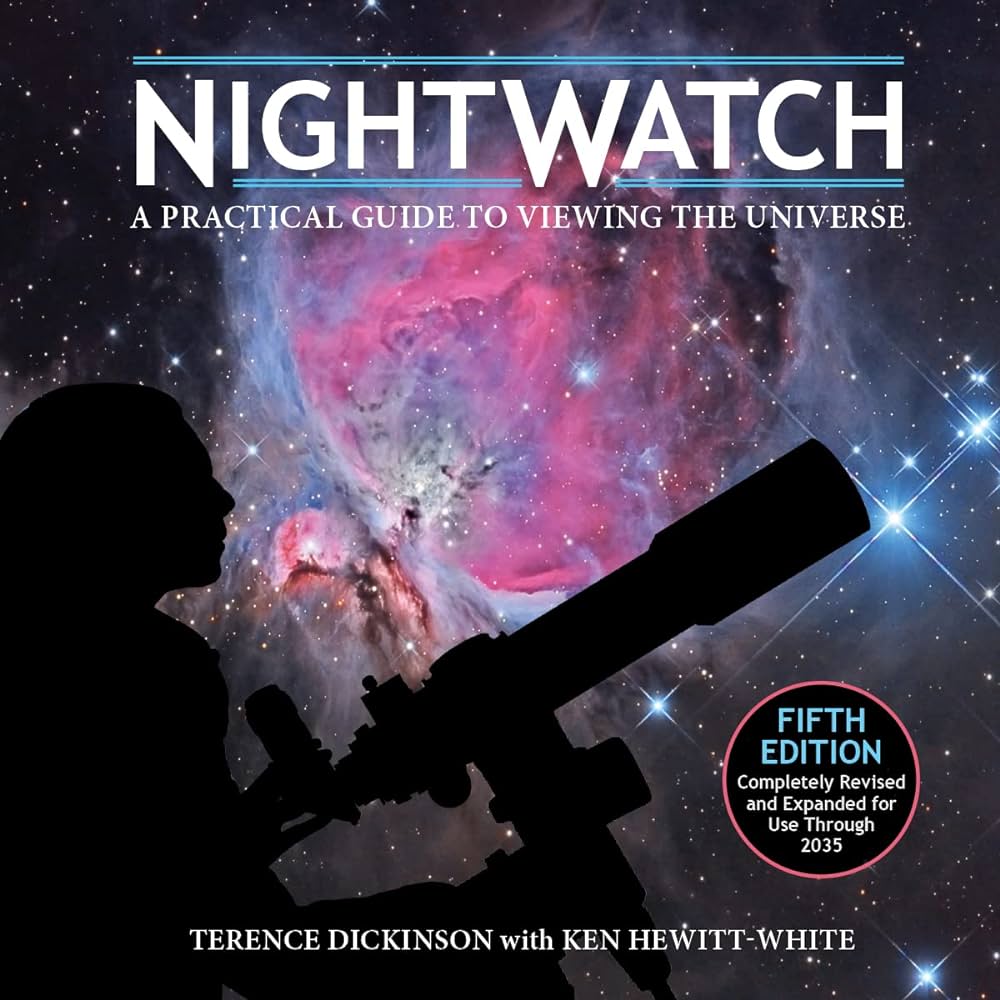
Unique Selling Points (USPs)
- Spiral-bound design with durable pages for easy use under the night sky.
- Detailed star charts and updates for each edition to reflect the current night sky.
- Photography tips for capturing celestial events.
- Environmentally friendly materials in its production.
Target Audience
Ideal for beginners and intermediate stargazers who seek a thorough yet accessible guide to observing the night sky.
Critical Reception
Widely praised for its clarity and usefulness, “NightWatch” has become a beloved staple in the amateur astronomy community, recommended by both educators and enthusiasts alike.
“A bible for amateur astronomers.” – Sky & Telescope
Comparisons
Often compared to “Turn Left at Orion” for its approachability, “NightWatch” is distinguished by its emphasis on visual aids and photography.
Author Background
Terence Dickinson is a celebrated astronomy author and educator, with over one million copies of his books sold. His expertise and passion for the stars have made him a respected figure in popularizing astronomy.
Reader Reviews and Ratings
Holds a stellar rating, with readers appreciating its practical advice, clear illustrations, and effective teaching style.
Includes seasonal sky charts, a guide to solar and lunar eclipses, and tips for photographing the night sky.
3. The Backyard Astronomer’s Guide
“The Backyard Astronomer’s Guide” by Terence Dickinson and Alan Dyer
“The Backyard Astronomer’s Guide” by Terence Dickinson and Alan Dyer is an expansive resource that covers all facets of amateur astronomy. This guide delves into equipment selection, celestial photography, and deep-sky observing, making it a treasure trove of information for enthusiasts.
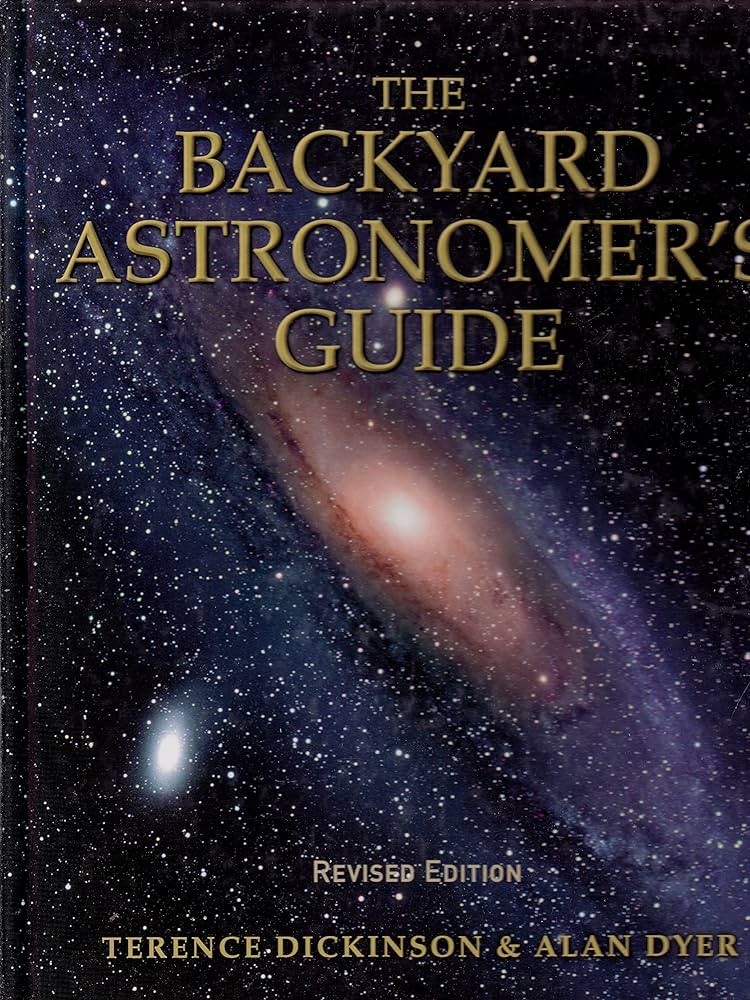
Unique Selling Points (USPs)
- Comprehensive coverage of telescopes, accessories, and observing techniques.
- High-quality photographs and illustrations to enhance understanding.
- In-depth discussions on astrophotography, including digital imaging techniques.
- Advice on combating light pollution, advocating for darker skies.
Target Audience
Designed for amateur astronomers at all levels, especially those interested in astrophotography and advanced observing.
Critical Reception
Acclaimed for its depth and breadth, the guide is frequently cited as a must-have reference for its practical insights and up-to-date information.
“Indispensable… A comprehensive guide for the amateur astronomer.” – Astronomy Magazine
Comparisons
While similar in target audience to “NightWatch,” this guide goes further into technical details, particularly around astrophotography and equipment.
Author Background
Terence Dickinson, with Alan Dyer, brings decades of astronomy expertise to the table. Dickinson’s celebrated writing and Dyer’s professional astronomy experience combine to create a detailed and authoritative guide.
Reader Reviews and Ratings
Highly rated for its thoroughness and quality of information, with many readers considering it an invaluable reference in their astronomical pursuits.
Features updated reviews of the latest telescopes and gear, as well as access to a companion website with additional resources.
4. 50 Things to See with a Small Telescope
“50 Things to See with a Small Telescope” by John A. Read
John A. Read’s “50 Things to See with a Small Telescope” serves as a quintessential guide for the amateur astronomer wielding a small telescope and a big curiosity about the night sky. This book stands out for its straightforward approach, offering readers a clear roadmap to observing celestial wonders from their own backyards. It demystifies the cosmos, making astronomy accessible and engaging for readers of all ages.
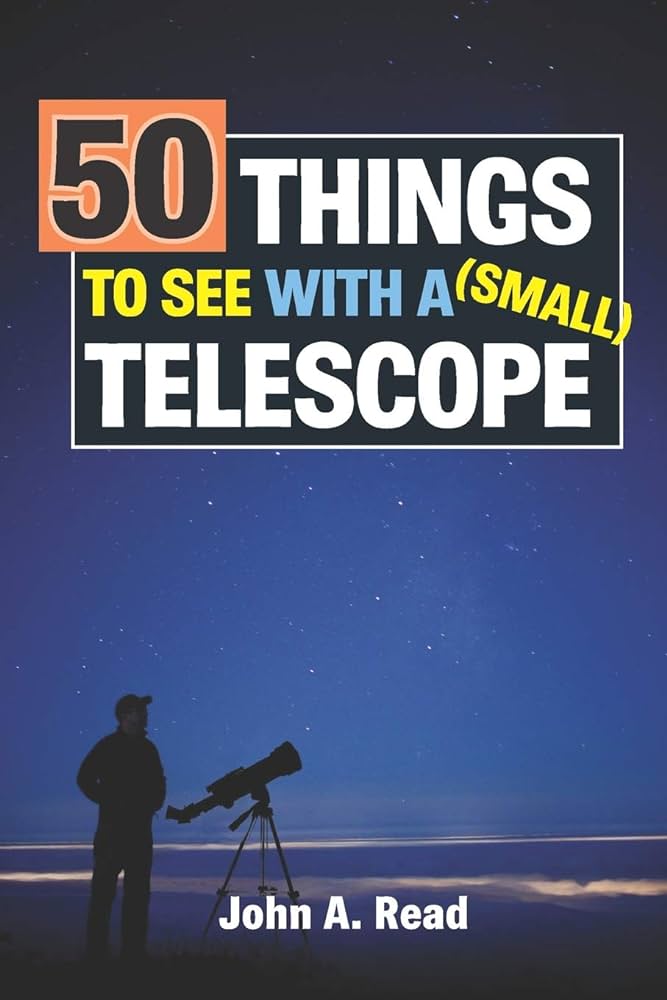
Unique Selling Points (USPs)
- Tailored for small telescopes, making astronomy approachable for beginners.
- Includes easy-to-follow star maps and eclipse charts updated through the year 2030.
- Features a “Telescope View” for each celestial object, providing a realistic expectation of what you’ll see.
- Covers a wide array of celestial phenomena, from planets and stars to galaxies and nebulae.
Target Audience
This book is ideal for astronomy beginners, young stargazers, and anyone with a small telescope looking to explore the night sky.
Critical Reception
Praised for its simplicity and effectiveness, the book has received positive acclaim from both amateur astronomers and top reviewers, recognized for making the night sky accessible to beginners.
“This delightful book covers the 50 things to see and some of them are: ‘North Star, Venus, Orion Nebula, Mars, Jupiter, The Milky Way, Comets, the International Space Station, and even birds’. Just a fascinating read for me…” – Top 500 Amazon Reviewer
Comparisons
While similar to other beginner astronomy books, “50 Things to See with a Small Telescope” is specifically praised for its practicality and focus on what can realistically be observed with less powerful telescopes.
Author Background
John A. Read’s journey in astronomy began with a simple, small telescope. His passion for sharing the wonders of the cosmos led him to write several astronomy books, aiming to make the subject accessible to everyone. He’s also a recipient of the Simon Newcomb Award for excellence in science communication.
Reader Reviews and Ratings
The book enjoys a high rating, celebrated for its clarity, useful directions for finding listed objects, and being a practical guide for beginners.
The book is complemented by updated star maps and a dedicated section for eclipse viewing, enhancing its value as a long-term resource for celestial observation.
5. Astronomy for Dummies
“Astronomy for Dummies” by Stephen P. Maran
Part of the renowned “For Dummies” series, “Astronomy for Dummies” by Stephen P. Maran, Ph.D., offers an inviting introduction to the wonders of the universe. With a focus on stargazing, this guide simplifies complex astronomical concepts, making them accessible to everyone. Whether you’re looking to identify constellations, understand celestial events, or just get started with a telescope, Maran’s expert advice makes it easy.
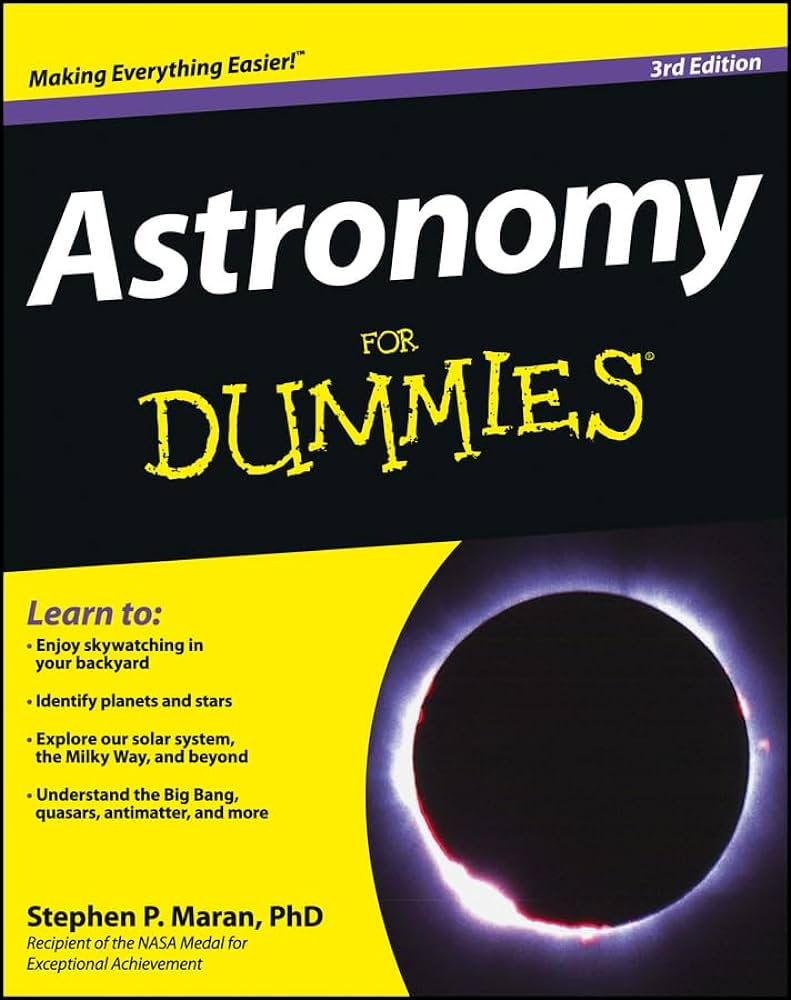
Unique Selling Points (USPs)
- Written by an astrophysics expert with decades of experience.
- Simplifies complex concepts with the series’ signature humor and clarity.
- Includes up-to-date information on celestial events and astronomical discoveries.
- Offers practical advice on choosing and using telescopes and binoculars.
Target Audience
Beginners to astronomy, curious minds looking to start their stargazing journey, and anyone seeking a comprehensive yet easy-to-understand guide to the night sky.
Critical Reception
As a trusted resource, it’s praised for its engaging writing style and the ability to make astronomy accessible to readers without a scientific background.
Comparisons
Compared to more specialized astronomy guides, “Astronomy for Dummies” is recognized for its broad appeal, balancing educational content with approachable language and practical tips.
Author Background
Stephen P. Maran, Ph.D., brings a wealth of experience from his career as an astrophysicist and his role as the spokesperson for the American Astronomical Society. His dedication to public science education shines through his writing.
Reader Reviews and Ratings
Typically receives high marks for its engaging approach and practical tips, making it a favorite among astronomy beginners.
Includes star charts, diagrams, and possibly online resources to complement the learning experience, catering to the evolving interests of astronomy enthusiasts.
6. Astronomy: A Beginner’s Guide to the Universe
“Astronomy: A Beginner’s Guide to the Universe” by Eric Chaisson and Steve McMillan
“Astronomy: A Beginner’s Guide to the Universe” by Eric Chaisson and Steve McMillan is an engaging gateway into the cosmos, meticulously crafted to bring the universe closer to beginners. Serving as a comprehensive textbook, it delves into the fundamental concepts of astronomy with clarity and precision. Through vivid imagery, cutting-edge information, and captivating narrative, Chaisson and McMillan guide readers across the celestial shores, from our solar neighborhood to the farthest galaxies.
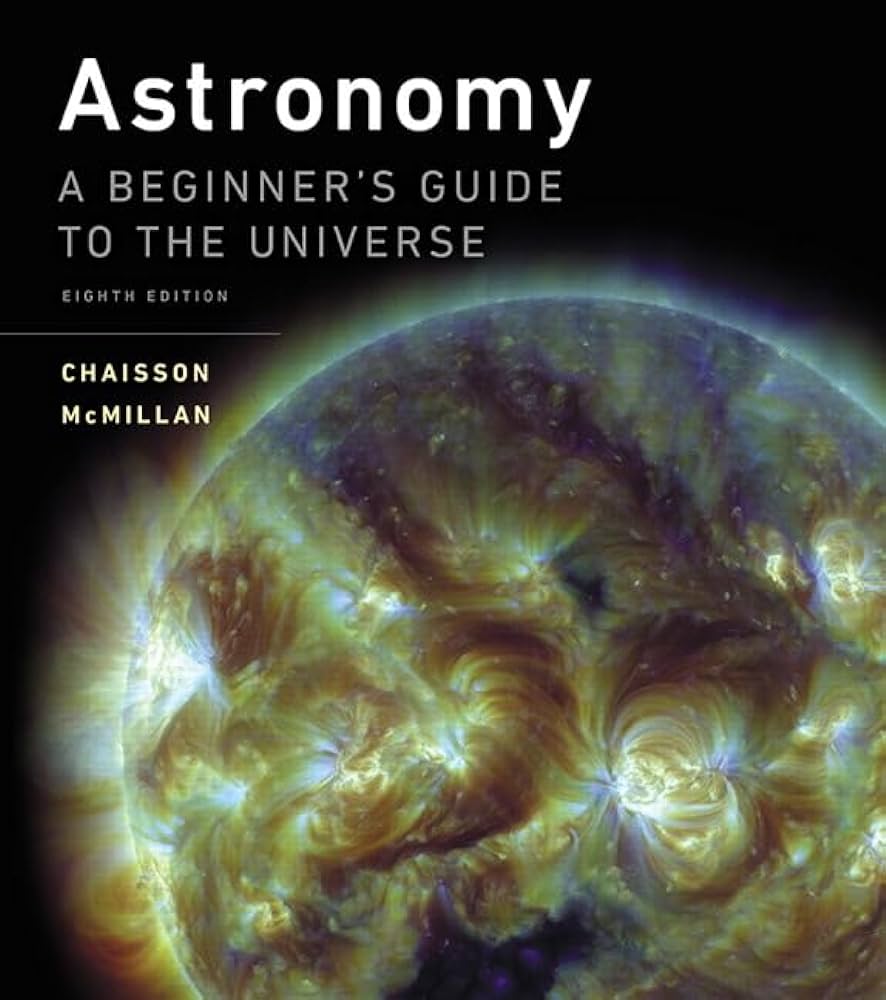
Unique Selling Points (USPs)
- Thorough coverage of astronomical principles and phenomena, from basic to advanced topics.
- Incorporates the latest discoveries and technological advancements in the field.
- Richly illustrated with photographs, diagrams, and charts to enhance understanding.
- Features interactive tools and resources for an immersive learning experience.
Target Audience
Ideal for students, educators, and anyone with a keen interest in gaining a solid foundation in astronomical concepts and current science.
Critical Reception
Highly regarded for its educational value, the book is celebrated for making complex subjects accessible without oversimplification.
Comparisons
While there are many introductory texts in astronomy, this book is distinguished by its depth of coverage and the authors’ ability to convey complex ideas in an understandable way.
Author Background
Eric Chaisson holds a Ph.D. in astrophysics from Harvard and has an extensive background in teaching and research. Steve McMillan holds a Ph.D. in astronomy from Harvard and is known for his contributions to the field and science education.
7. Astronomy: A Self-Teaching Guide
“Astronomy: A Self-Teaching Guide” by Dinah L. Moche
Dinah L. Moche’s “Astronomy: A Self-Teaching Guide” is a dynamic, hands-on resource that empowers readers to explore the universe from their own backyards. Designed with a workbook approach, it presents clear learning objectives, self-tests, and review questions that encourage active participation in the learning process. It’s an ideal companion for beginners who prefer a structured path to discovering astronomy.
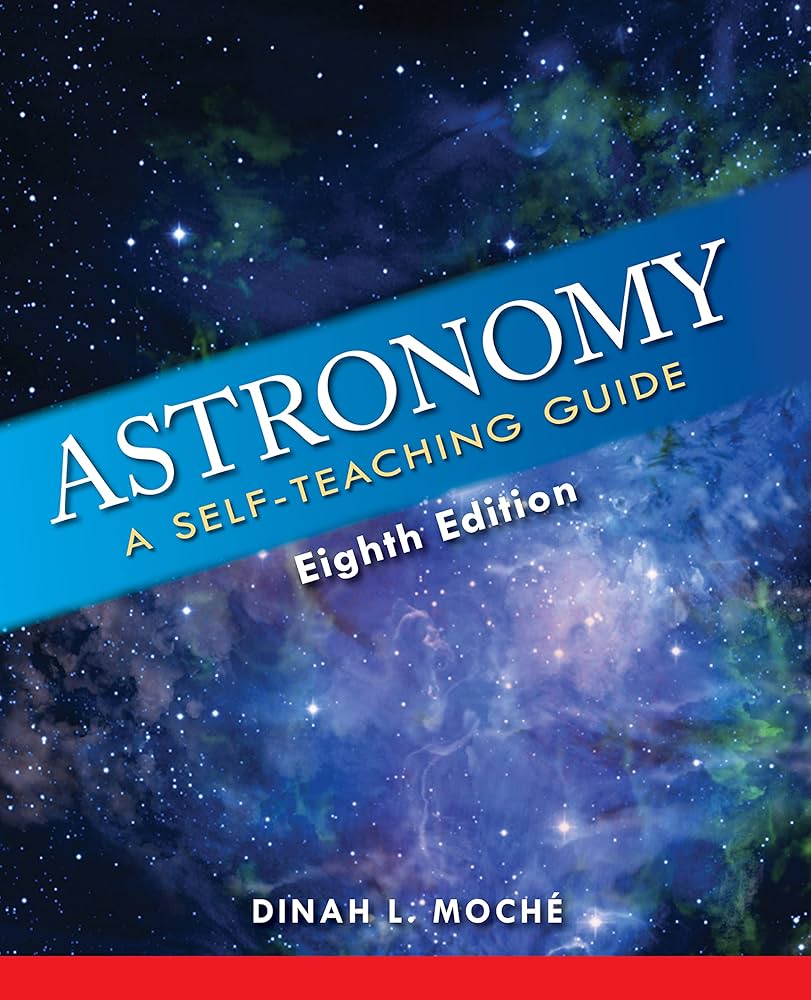
Unique Selling Points (USPs)
- Self-paced learning structure with objectives and tests for each chapter.
- Up-to-date information reflecting current astronomical research and findings.
- Practical observing tips that enhance the amateur astronomer’s experience.
- Accessibility to a broad audience with or without a science background.
Target Audience
Beginners in astronomy who appreciate a structured, self-guided approach to learning, including students and hobbyists.
Critical Reception
Praised for its effective teaching method, the guide has been a popular choice among learners for its practicality and clarity.
Author Background
Dinah L. Moche is a celebrated author and professor of physics and astronomy, with a talent for making astronomy accessible to a wide audience.
8. The Astronomy Book: Big Ideas Simply Explained
“The Astronomy Book: Big Ideas Simply Explained” by DK
“The Astronomy Book: Big Ideas Simply Explained” by DK is a part of the highly acclaimed “Big Ideas” series, known for distilling complex subjects into essential, understandable elements. This volume takes readers on a journey through astronomical theories and concepts, explaining them in a straightforward, accessible manner. With DK’s signature visual style, the book breaks down the universe’s mysteries into bite-sized, digestible pieces of information.
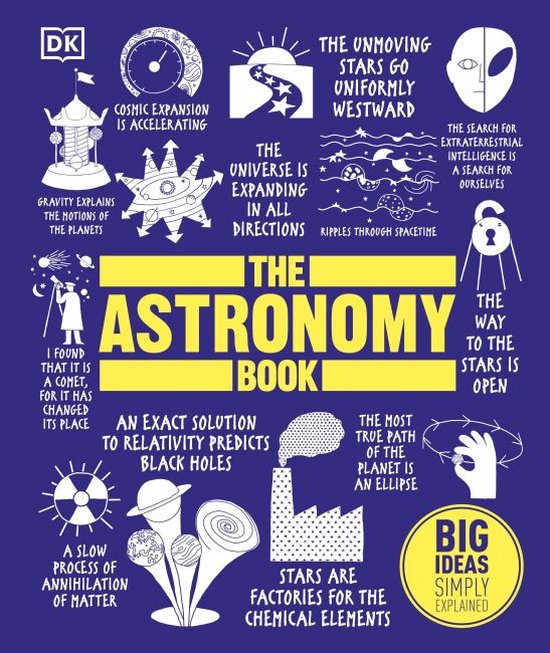
Unique Selling Points (USPs)
- Simplifies complex astronomical theories and concepts for easy understanding.
- Features DK’s renowned high-quality graphics and illustrations.
- Presents information in bite-sized chunks, ideal for quick learning and reference.
- Part of the “Big Ideas” series, known for reliable and clear explanations.
Target Audience
Perfect for readers seeking a clear, concise overview of astronomy without getting bogged down in technical details, including students, educators, and general science enthusiasts.
Critical Reception
The book is well-received for its ability to make astronomy approachable, complimented by its visual appeal and clear presentation.
Author Background
DK is known for its commitment to producing high-quality reference materials on a wide range of topics, crafted by a team of experts to ensure accuracy and accessibility.
9. Astronomy 101
“Astronomy 101: From the Sun and Moon to Wormholes and Warp Drive” by Carolyn Collins Petersen
Carolyn Collins Petersen’s “Astronomy 101” takes readers on an exhilarating journey from the familiar sights of our night sky to the fantastical realms of black holes and distant galaxies. This engaging book serves as a comprehensive primer to the universe, breaking down astronomical concepts and milestones in a digestible and accessible format. It’s an invitation to understand the cosmos, providing a wide-ranging overview of the most captivating aspects of astronomy.
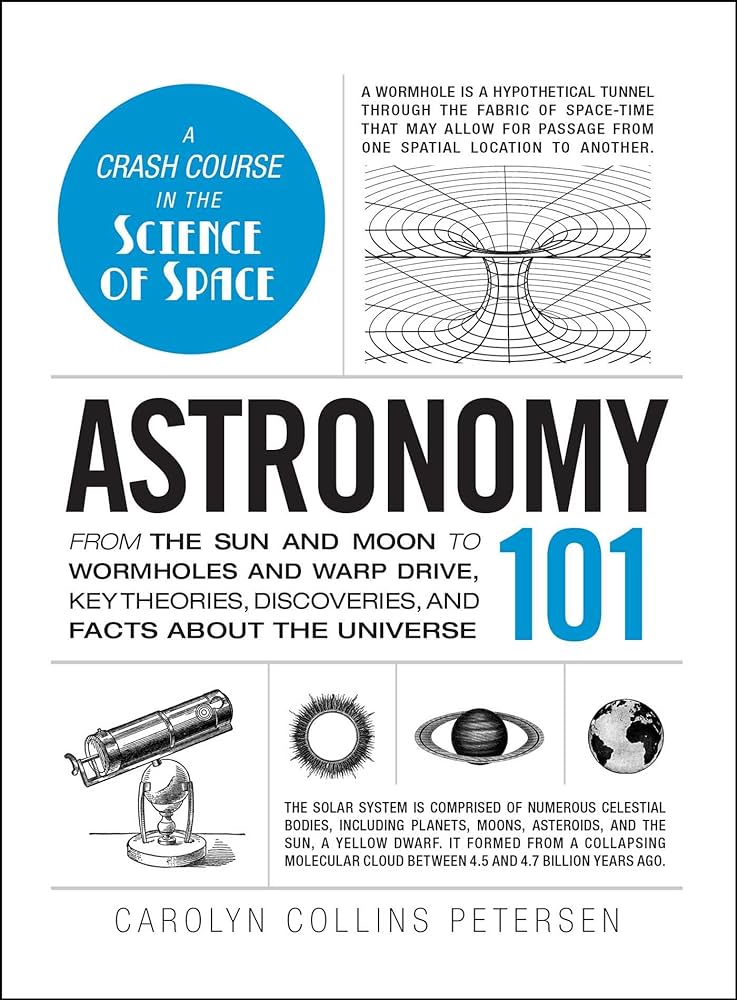
Unique Selling Points (USPs)
- Explores a wide array of topics, from basic celestial phenomena to advanced theoretical physics.
- Written in an accessible language that demystifies complex concepts.
- Incorporates the latest astronomical discoveries and theories.
- Offers insights into the future of space exploration and the universe’s mysteries.
Target Audience
Curious minds with an interest in astronomy and the universe’s workings, seeking a broad yet comprehensive overview without the complexity of a textbook.
Critical Reception
The book is praised for its clarity, breadth, and engaging writing style, making it a favored choice for readers looking to start their astronomical journey.
Author Background
Carolyn Collins Petersen is a celebrated science writer and communicator, with a knack for translating complex scientific ideas into engaging narratives. Her expertise and passion for astronomy shine through in this enlightening guide.
10. The Universe in a Nutshell
“The Universe in a Nutshell” by Stephen Hawking
Brief Introduction
In “The Universe in a Nutshell,” Stephen Hawking extends the exploration of the cosmos that he began in “A Brief History of Time.” This landmark book provides updates on theoretical physics, tackling subjects like supergravity, naked singularities, and the possibility of a unified theory. Hawking’s profound insights are presented with his characteristic wit and clarity, making cutting-edge science accessible to the general reader. This book serves as a window into the mind of one of the most brilliant physicists of our time.

Unique Selling Points (USPs)
- Provides updates and expands on concepts introduced in Hawking’s previous works.
- Utilizes illustrations and clear explanations to demystify complex theories.
- Reflects Hawking’s deep insights into the nature of the universe.
- Accessible to readers without a background in physics.
Target Audience
Readers interested in the latest developments in theoretical physics and the universe’s fundamental principles, seeking insight from one of the field’s leading minds.
Critical Reception
Acclaimed for its ability to make profound scientific ideas understandable and engaging, Hawking’s work is celebrated worldwide for its contribution to public understanding of physics.
Author Background
Stephen Hawking was a theoretical physicist, cosmologist, and author, renowned for his work on black holes and his ability to popularize science. His intellect and perseverance, despite his battle with ALS, made him a legendary figure in the scientific community and beyond.
Essential Tools for Stargazing Rather than Astronomy Books for Beginners
Telescopes for Beginners
Embarking on the journey of stargazing begins with choosing the right telescope, a window to the cosmos. The two primary types, refractors and reflectors, offer distinct advantages. Refractor telescopes, with their lenses at the front, provide sharp, high-contrast images, making them excellent for lunar and planetary observations. Reflectors, utilizing mirrors, excel in capturing faint light from deep-sky objects like nebulae and galaxies, offering a wider aperture at a lower cost. For your first telescope, prioritize ease of use, stability, and quality of optics over magnification. Recommended starter models include the Orion StarBlast 4.5 Astro Reflector and the Celestron AstroMaster 70AZ Refractor, both of which balance quality with beginner-friendly operation.
Stargazing Without a Telescope
The cosmos’s beauty can be appreciated with minimal equipment. Binoculars, often overlooked, serve as an ideal starting point, offering portability and a wide field of view for sweeping the Milky Way or tracing constellations. Opt for models with specifications like 7×50 or 10×50 to ensure a balance between light gathering and stability. Furthermore, the naked eye alone can unlock the night’s wonders, from spotting the International Space Station (ISS) zipping across the sky to witnessing the ethereal glow of the zodiacal light. Begin your exploration by familiarizing yourself with major constellations, serving as celestial signposts to deeper cosmic treasures.
Navigating the Night Sky
- Understanding Celestial Coordinates
Just as latitude and longitude guide us on Earth, celestial coordinates allow us to locate stars, planets, and other celestial bodies. This system uses right ascension (RA) and declination (Dec) to pinpoint objects in the sky. Learning to read a star chart or use a planisphere can unlock the night sky’s layout, guiding you from one celestial highlight to another with precision. Practice aligning your chart with the sky, using well-known stars or constellations as anchors to navigate the celestial sphere.
- Seasonal Skies
The night sky is a dynamic canvas, changing with the seasons due to Earth’s orbit around the Sun. Each season brings its own set of constellations and celestial events. In spring, look for Leo the Lion and Virgo the Maiden; summer nights offer a glimpse of the Milky Way, with Scorpius and Sagittarius taking center stage; autumn reveals the Great Square of Pegasus; and winter boasts some of the brightest stars, with Orion the Hunter dominating the heavens. Embrace the rhythm of the cosmos by observing these seasonal shifts and the endless dance of the stars.

Observing Celestial Objects
- The Moon and Planets
Our closest celestial neighbors, the Moon and planets, provide captivating views and are excellent targets for beginners. The Moon, with its craters and seas, offers endless exploration opportunities, especially along the terminator line where shadows reveal breathtaking details. Planets like Jupiter, with its moons, and Saturn, with its rings, can be observed with modest equipment, revealing their beauty and complexity. Track their movements using apps or guides to predict their positions and best viewing times.
- Deep Sky Objects
Beyond our solar system, the universe teems with galaxies, nebulae, and star clusters. These deep-sky objects, while challenging, are within reach of amateur astronomers. Start with the bright and easy-to-find objects like the Orion Nebula (M42), the Andromeda Galaxy (M31), and the Pleiades (M45). Each offers a gateway to the universe’s vastness and a glimpse into the cosmic processes shaping it.
- Meteor Showers and Eclipses
Meteor showers, such as the Perseids and Geminids, offer spectacular shows of celestial fireworks. Prepare by finding a dark, open sky and allowing your eyes to adjust to the darkness. Eclipses, both solar and lunar, provide awe-inspiring celestial events that draw observers worldwide. Use protective eyewear for solar eclipses and enjoy the gradual drama of lunar eclipses with the naked eye. Check astronomical calendars for dates and times, and plan your observation to ensure the best experience.
Practical Tips for New Astronomers
- Setting Up Observation Sessions
Embarking on a stargazing adventure requires thoughtful preparation and a keen eye on the sky. Start by selecting an observation location away from the light pollution of urban areas to unveil the night’s true majesty. Dark sky parks or rural settings are ideal. Next, align your stargazing sessions with significant celestial events—planetary alignments, meteor showers, or eclipses—to maximize the experience. Equally crucial is monitoring the weather; clear, cloudless skies are your ally, offering the best visibility. Utilize weather apps and astronomical forecasts to pick optimal viewing nights, and remember, patience is a stargazer’s virtue, as conditions can change.
- Joining the Astronomy Community
Astronomy, while a solitary pursuit at times, flourishes through community. Joining a local astronomy club can enrich your experience with shared knowledge, viewing parties, and camaraderie. Clubs often offer workshops, guest speakers, and telescope lending programs for beginners. Online communities and forums are treasure troves of information, where enthusiasts share tips, observations, and encouragement. Websites like the Astronomical League or apps like Star Walk can connect you to events and fellow astronomers. Engaging with these communities not only accelerates your learning curve but also embeds you within a network of support and shared passion.
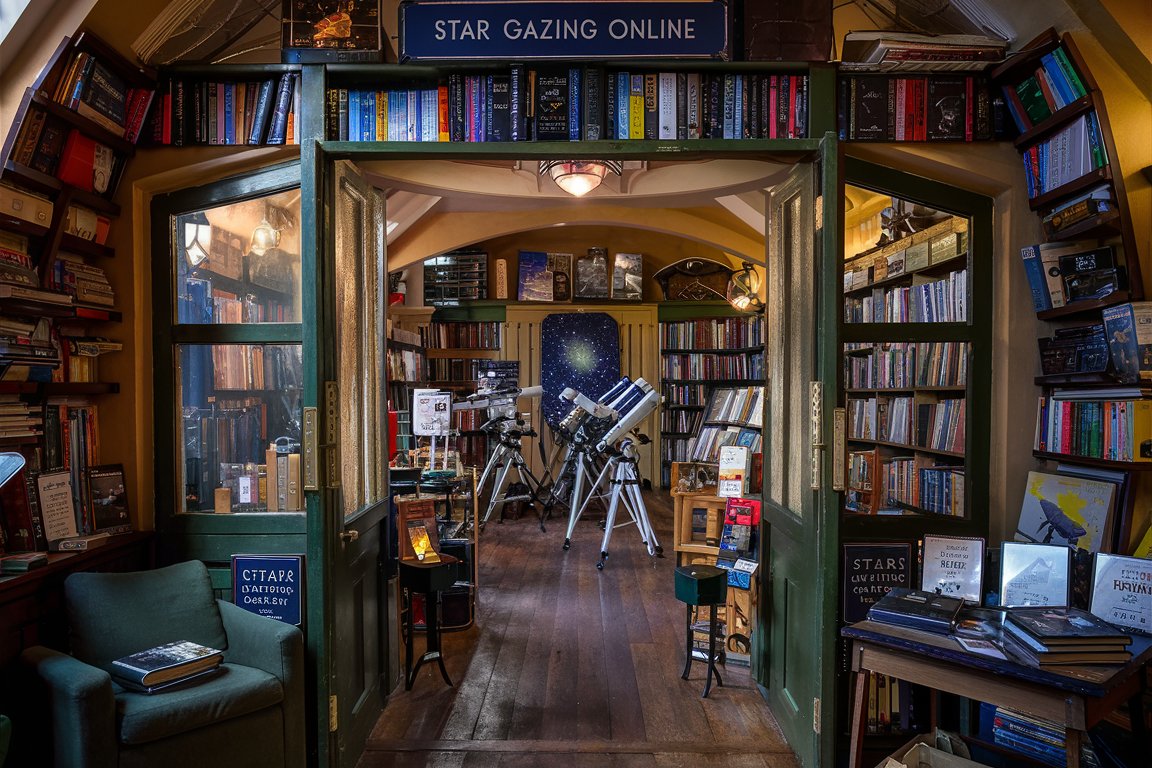
Conclusion
The universe invites us all to explore its vast mysteries, and your journey through the cosmos is just beginning. Each night under the stars brings new discoveries, challenges, and wonders. Embrace the learning process, for astronomy is a field where the frontier of knowledge is always expanding. Celebrate your observations, share your experiences, and never hesitate to ask questions within the astronomy community. Remember, every expert astronomer was once a beginner, gazing up at the night sky with curiosity and awe. Continue to explore, learn, and connect with the cosmos and your fellow stargazers. The universe is yours to discover.



